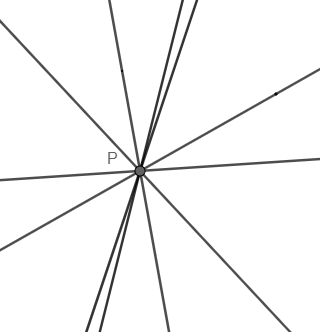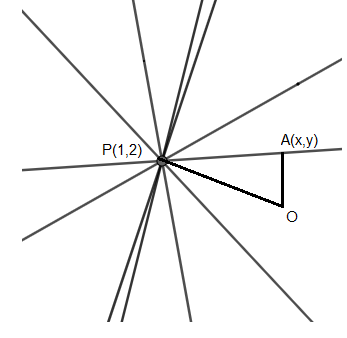
The locus of the foot of the perpendicular from the origin on each member of the family \[(4a+3)x-(a+1)y-(2a+1)=0\] is
(a). \[{{(2x-1)}^{2}}+4{{(y+1)}^{2}}=5\]
(b). \[{{(2x-1)}^{2}}+{{(y+1)}^{2}}=5\]
(c). \[{{(2x+1)}^{2}}+4{{(y-1)}^{2}}=5\]
(d). \[{{(2x-1)}^{2}}+4{{(y-1)}^{2}}=5\]
Answer
221.1k+ views
Hint:- In this question first we have to find the value of the point of intersection of the family of straight lines then apply Pythagoras theorem to get the required answer.
Complete step-by-step solution -
The equation of the family of lines is,
\[(4a+3)x-(a+1)y-(2a+1)=0\]
Expanding this, we get
\[4ax+3x-ay-y-2a-1=0\]
Now regrouping them, we get
\[3x-y-1+a(4x-y-2)=0\]
Now this is of the form \[{{L}_{1}}+\lambda {{L}_{2}}=0\].
Let the point of intersection of these two lines, i.e., \[3x-y-1=0\]and \[4x-y-2=0\]be P.
So, the given family of lines will pass through this fixed point P, as shown below.

Now we will find the coordinates of point P.
Consider,
\[3x-y-1=0\]
\[3x=y+1\]
\[x=\dfrac{y+1}{3}........(i)\]
Substitute this value in other equation of line, we get
\[4x-y-2=0\]
\[4\left( \dfrac{y+1}{3} \right)-y-2=0\]
\[\dfrac{4y+4-3y-(3\times 2)}{3}=0\]
\[y+4-6=0\]
\[y=6-4=2\]
Substituting the value of ‘y’ in equation (i), we get
\[x=\dfrac{2+1}{3}=\dfrac{3}{3}=1\]
So, the point of intersection of the family of lines is \[P(1,2)\].
Now, there is a perpendicular drawn from the origin onto each line. Let the foot of the perpendicular on each line be \[A(x,y)\], as shown below.

Now the points OPA will form a right-angled triangle in all the lines.
Applying Pythagoras theorem on \[\Delta OPA\], we get
\[O{{P}^{2}}=O{{A}^{2}}+A{{P}^{2}}.........(ii)\]
We know the distance between points \[({{x}_{1}},{{y}_{1}})\]and \[({{x}_{2}},{{y}_{2}})\]is given by the distance formula, i.e.,
\[\sqrt{{{({{x}_{2}}-{{x}_{1}})}^{2}}+{{({{y}_{2}}-{{y}_{1}})}^{2}}}\]
Applying the distance formula in equation (ii), we get
\[{{\left( \sqrt{{{(1-0)}^{2}}+{{(2-0)}^{2}}} \right)}^{2}}={{\left( \sqrt{{{(x-0)}^{2}}+{{(y-0)}^{2}}} \right)}^{2}}+{{\left( \sqrt{{{(x-1)}^{2}}+{{(y-2)}^{2}}} \right)}^{2}}\]
\[{{1}^{2}}+{{2}^{2}}={{x}^{2}}+{{y}^{2}}+{{(x-1)}^{2}}+{{(y-2)}^{2}}\]
Expanding, we get
\[1+4={{x}^{2}}+{{y}^{2}}+({{x}^{2}}+1-2x)+({{y}^{2}}+4-4y)\]
\[5=2{{x}^{2}}+2{{y}^{2}}+1-2x+4-4y\]
As this is not matching with the options, we will multiply the above equation with \[2\], we get
\[10=4{{x}^{2}}+4{{y}^{2}}+2-4x+8-8y\]
Grouping them, we get
\[4{{x}^{2}}-4x+2+4{{y}^{2}}-8y+8=10\]
Now we will try to convert this into \[{{(a+b)}^{2}}\]form, as in options.
\[\left( 4{{x}^{2}}-4x+1 \right)+1+4({{y}^{2}}-2y+1)+4=10\]
We know, \[\left( {{a}^{2}}-2ab+{{b}^{2}} \right)={{(a+b)}^{2}}\], so above equation can be re-written as,
\[{{\left( 2x-1 \right)}^{2}}+4{{(y-1)}^{2}}=10-4-1\]
\[{{\left( 2x-1 \right)}^{2}}+4{{(y-1)}^{2}}=5\]
So, the locus of the foot of the perpendicular from the origin on each member of the family \[(4a+3)x-(a+1)y-(2a+1)=0\] is \[{{\left( 2x-1 \right)}^{2}}+4{{(y-1)}^{2}}=5\].
Hence, the correct answer is option (d).
Note: Another method to find the answer is, instead of using Pythagoras theorem; we can find the slope of the equation of perpendicular line from the origin to a point. Then applying the formula, $y=mx+c$. But this would be a lengthy process.
Complete step-by-step solution -
The equation of the family of lines is,
\[(4a+3)x-(a+1)y-(2a+1)=0\]
Expanding this, we get
\[4ax+3x-ay-y-2a-1=0\]
Now regrouping them, we get
\[3x-y-1+a(4x-y-2)=0\]
Now this is of the form \[{{L}_{1}}+\lambda {{L}_{2}}=0\].
Let the point of intersection of these two lines, i.e., \[3x-y-1=0\]and \[4x-y-2=0\]be P.
So, the given family of lines will pass through this fixed point P, as shown below.

Now we will find the coordinates of point P.
Consider,
\[3x-y-1=0\]
\[3x=y+1\]
\[x=\dfrac{y+1}{3}........(i)\]
Substitute this value in other equation of line, we get
\[4x-y-2=0\]
\[4\left( \dfrac{y+1}{3} \right)-y-2=0\]
\[\dfrac{4y+4-3y-(3\times 2)}{3}=0\]
\[y+4-6=0\]
\[y=6-4=2\]
Substituting the value of ‘y’ in equation (i), we get
\[x=\dfrac{2+1}{3}=\dfrac{3}{3}=1\]
So, the point of intersection of the family of lines is \[P(1,2)\].
Now, there is a perpendicular drawn from the origin onto each line. Let the foot of the perpendicular on each line be \[A(x,y)\], as shown below.

Now the points OPA will form a right-angled triangle in all the lines.
Applying Pythagoras theorem on \[\Delta OPA\], we get
\[O{{P}^{2}}=O{{A}^{2}}+A{{P}^{2}}.........(ii)\]
We know the distance between points \[({{x}_{1}},{{y}_{1}})\]and \[({{x}_{2}},{{y}_{2}})\]is given by the distance formula, i.e.,
\[\sqrt{{{({{x}_{2}}-{{x}_{1}})}^{2}}+{{({{y}_{2}}-{{y}_{1}})}^{2}}}\]
Applying the distance formula in equation (ii), we get
\[{{\left( \sqrt{{{(1-0)}^{2}}+{{(2-0)}^{2}}} \right)}^{2}}={{\left( \sqrt{{{(x-0)}^{2}}+{{(y-0)}^{2}}} \right)}^{2}}+{{\left( \sqrt{{{(x-1)}^{2}}+{{(y-2)}^{2}}} \right)}^{2}}\]
\[{{1}^{2}}+{{2}^{2}}={{x}^{2}}+{{y}^{2}}+{{(x-1)}^{2}}+{{(y-2)}^{2}}\]
Expanding, we get
\[1+4={{x}^{2}}+{{y}^{2}}+({{x}^{2}}+1-2x)+({{y}^{2}}+4-4y)\]
\[5=2{{x}^{2}}+2{{y}^{2}}+1-2x+4-4y\]
As this is not matching with the options, we will multiply the above equation with \[2\], we get
\[10=4{{x}^{2}}+4{{y}^{2}}+2-4x+8-8y\]
Grouping them, we get
\[4{{x}^{2}}-4x+2+4{{y}^{2}}-8y+8=10\]
Now we will try to convert this into \[{{(a+b)}^{2}}\]form, as in options.
\[\left( 4{{x}^{2}}-4x+1 \right)+1+4({{y}^{2}}-2y+1)+4=10\]
We know, \[\left( {{a}^{2}}-2ab+{{b}^{2}} \right)={{(a+b)}^{2}}\], so above equation can be re-written as,
\[{{\left( 2x-1 \right)}^{2}}+4{{(y-1)}^{2}}=10-4-1\]
\[{{\left( 2x-1 \right)}^{2}}+4{{(y-1)}^{2}}=5\]
So, the locus of the foot of the perpendicular from the origin on each member of the family \[(4a+3)x-(a+1)y-(2a+1)=0\] is \[{{\left( 2x-1 \right)}^{2}}+4{{(y-1)}^{2}}=5\].
Hence, the correct answer is option (d).
Note: Another method to find the answer is, instead of using Pythagoras theorem; we can find the slope of the equation of perpendicular line from the origin to a point. Then applying the formula, $y=mx+c$. But this would be a lengthy process.
Recently Updated Pages
The maximum number of equivalence relations on the-class-11-maths-JEE_Main

A train is going from London to Cambridge stops at class 11 maths JEE_Main

Find the reminder when 798 is divided by 5 class 11 maths JEE_Main

An aeroplane left 50 minutes later than its schedu-class-11-maths-JEE_Main

A man on the top of a vertical observation tower o-class-11-maths-JEE_Main

In an election there are 8 candidates out of which class 11 maths JEE_Main

Trending doubts
Understanding Atomic Structure for Beginners

Understanding Entropy Changes in Different Processes

Common Ion Effect: Concept, Applications, and Problem-Solving

What Are Elastic Collisions in One Dimension?

Free Radical Substitution and Its Stepwise Mechanism

Understanding Geostationary and Geosynchronous Satellites

Other Pages
Cbse Class 11 Maths Notes Chapter 9 Straight Lines

NCERT Solutions for Class 11 Maths Chapter 6 Permutations And Combinations

NCERT Solutions For Class 11 Maths Chapter 11 Introduction To Three Dimensional Geometry - 2025-26

NCERT Solutions for Class 11 Maths Chapter 7 Binomial Theorem

JEE Advanced 2026 Revision Notes for Practical Organic Chemistry

NCERT Solutions For Class 10 Maths Chapter 10 Conic Sections Exercise 10.3 - 2025-26




